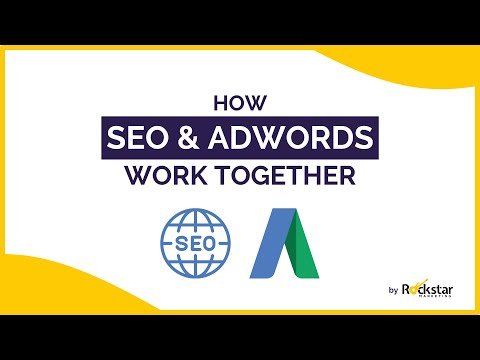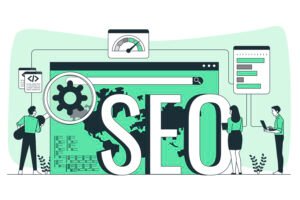If you’ve ever wondered whether SEO and AdWords (now called Google Ads) can work together, the answer is a resounding yes. While these two strategies may seem like they operate separately, when combined, they create a powerful digital marketing duo. SEO focuses on boosting your organic traffic by improving your site’s ranking in search results, while AdWords helps you gain immediate visibility through paid ads. Both methods serve different purposes, but together, they can take your marketing efforts to the next level.

What Is Google AdWords?
Google AdWords, now known as Google Ads, is a paid advertising platform by Google that allows businesses to display their ads on Google’s search engine results pages (SERPs) and across its advertising network. When users search for specific keywords, Google Ads enables advertisers to bid on these terms, placing their ads at the top or bottom of the search results. Advertisers are charged on a pay-per-click (PPC) model, meaning they only pay when a user clicks on their ad.
The platform is a powerful tool for businesses aiming for immediate visibility, driving traffic, and attracting potential customers. Whether you’re running a local business or an e-commerce store, Google Ads can target the right audience with the right message at the exact time they’re searching for relevant services or products. I think you guys know about SEO. If you guys Don’t know about SEO Then readout this: What is SEO

Difference between SEO and AdWords
Before diving into how they work together, let’s break down the core differences between SEO and AdWords.
-
SEO (Search Engine Optimization): This involves optimizing your website so it appears higher in organic search results. It’s a long-term strategy that builds up over time through methods like keyword optimization, improving website structure, and earning backlinks.
-
AdWords (Google Ads): AdWords is Google’s paid advertising platform, where you can bid on keywords so your ads appear at the top of the search results page. It’s a way to get immediate visibility, but you pay each time someone clicks on your ad (Pay-Per-Click, or PPC).

Difference Between PPC and AdWords
Pay-Per-Click (PPC) is an online advertising approach in which advertisers pay a fee when one of their adverts is clicked. It is a strategy of purchasing visits to your website rather than gaining them naturally. The most common PPC platform is Google Ads (formerly AdWords), but PPC can also occur on platforms like Bing Ads, Facebook Ads, and others.
Google Ads, especially, is a PPC platform offered by Google. When people refer to AdWords, they’re talking about Google’s specific service for running PPC campaigns. While PPC is a broader advertising method, AdWords is a tool that helps you run PPC ads on Google search engine results pages (SERPs) and Google’s advertising network.
The key difference is that PPC is the model and AdWords is the platform that enables advertisers to run those PPC campaigns on Google.
How SEO Works
Search Engine Optimization (SEO) is the process of optimizing your website to improve its visibility organically (without paying) in search engine results. The goal is to make your website more attractive to search engines like Google so that it ranks higher when users search for keywords related to your business. Unlike Google Ads, SEO focuses on long-term growth and sustainable traffic.
SEO is driven by three main elements:
-
On-page SEO: optimizing the content, meta tags, and structure of your website’s pages to make them more search engine-friendly.
-
Off-page SEO: Building high-quality backlinks from other sites to improve your website’s authority.
-
Technical SEO: Ensuring your website meets search engine requirements in terms of speed, mobile optimization, and site structure.
Together, these factors help search engines understand your website better, rewarding you with higher rankings for relevant searches.
How AdWords Work
Google Ads work through a bidding system called Google Ads Auction. Advertisers bid on keywords that they expect future customers will search for. Based on the bid amount and the quality of the ad (ad relevance, click-through rate, etc.), Google determines where the ad will be placed.
Here’s how the process works:
-
Keyword Selection: Advertisers select keywords they want their ads to appear for.
-
Ad Creation: Ads are created based on the keywords, focusing on user intent.
-
Bidding: Advertisers set a maximum bid they’re willing to pay for each click.
-
Ad Auction: Google runs an auction when a user searches for the keyword, determining the placement of each ad based on the bid and ad quality.
-
Ad Display: The page with the search results displays the winning advertisements.
Advertisers pay when users click on their ads, and Google’s system ensures that ads are relevant, helping to create a seamless experience for users.
How SEO and AdWords Work Together
SEO (Search Engine Optimization) and Google AdWords (now known as Google Ads) are two powerful digital marketing strategies that, when used together, can amplify your online presence and drive greater success for your business. While SEO focuses on gaining organic traffic by improving your website’s ranking in search engine results, AdWords is a paid advertising platform that provides immediate visibility at the top of search results.
Here’s how to make a marketing plan by combining these two strategies to create a stronger, more effective approach.
1. Dominating the Search Results
By using both SEO and Google Ads, you can dominate the first page of search results. SEO works to earn a high ranking in the organic listings, while Google Ads places your business at the top or bottom of the page as a paid ad. This gives your brand double the visibility, making it more likely that users will click on your link, whether through the organic listing or the ad.
- Example: A user searches for “best coffee shop in New York.” Your business appears both as a paid Google Ad at the top and as an organic result. This dual presence increases the chances that the user will click on your website.
2. Enhanced Data for Better Keyword Targeting
When you run both SEO and Google Ads campaigns, you gather a wealth of data on keyword performance. Google Ads provides real-time insights into which keywords are driving traffic, conversions, and engagement. You can use this data to refine your SEO strategy by focusing on high-performing keywords that show strong results in paid campaigns.
- Example: If a particular keyword is leading to many clicks and conversions through your Google Ads, you can optimize your website’s content and meta tags around that keyword for better SEO rankings.
3. Faster Results with Long-Term Impact
One of the key benefits of using Google Ads alongside SEO is the speed of results. While SEO can take months to show significant improvements in ranking, Google Ads delivers immediate traffic as soon as your campaign is live. Running ads helps you attract traffic and gather user data quickly, which can inform your SEO strategy for better long-term results.
- Example: You can test different headlines, descriptions, and landing pages in Google Ads to see what resonates with your audience. This data can then be used to optimize your website’s SEO content for long-term growth.
4. Improving Your Quality Score and Lowering Costs
SEO can directly impact the performance of your Google Ads campaign. Google assigns a Quality Score to each ad based on relevance, predicted click-through rate (CTR), and landing page quality. Well-optimized pages, which are a result of good SEO, improve user experience and are considered more relevant by Google.
- How This Helps: A high-quality score means your ads will rank higher in Google Ads auctions, and you’ll pay less per click. By focusing on SEO to create a seamless, relevant user experience, you can reduce your PPC costs over time.
5. Brand Trust and Authority
Users are more likely to trust a business that appears in both paid and organic search results. Seeing your brand twice on the same page, once in the ads and once in the organic results, builds credibility and increases the likelihood that the user will click through to your website.
- Benefit: This combined approach not only improves click-through rates but also builds long-term trust with your audience, helping you stay top-of-mind even when they’re not ready to make an immediate purchase.
6. Improving Click-Through Rates (CTR)
Using both SEO and Google Ads can significantly boost your overall click-through rates (CTR). Some users prefer to click on paid ads because they’re at the top of the page, while others trust organic results more. By appearing in both places, you capture traffic from different types of users, which leads to more overall clicks and conversions.
- Tip: Use consistent messaging in both your paid ads and SEO content to reinforce your brand’s message, ensuring that whichever link users click on, they find relevant and engaging information.
7. A/B Testing for SEO with Google Ads
Google Ads is a great platform for A/B testing different elements of your marketing strategy, such as headlines, descriptions, and landing pages. These tests can quickly reveal what works best for your target audience. You can then apply these learnings to your SEO strategy by incorporating high-performing elements into your website’s meta titles, descriptions, and content.
- Example: If a particular ad headline drives a lot of clicks in your Google Ads campaign, consider using that same headline or a variation of it in your organic search content to boost engagement.
Ways Google Ads Improve SEO
While Google Ads and SEO are two distinct strategies, they can complement each other to create a robust digital marketing approach. Although using Google Ads doesn’t directly impact your organic rankings, there are indirect ways that it can improve your overall SEO performance.
-
Increased Traffic: Google Ads can drive more traffic to your website, especially in the early stages of an SEO campaign. This immediate influx of visitors provides data on which pages and keywords are performing well, helping refine your SEO strategy.
-
Better Keyword Insights: Running Google Ads campaigns allows businesses to gather keyword data, such as which terms lead to conversions and which don’t. This data can be used to optimize your SEO efforts and focus on high-performing keywords organically.
-
Improved Brand Awareness: By appearing at the top of both paid ads and organic results, your brand becomes more visible. The increased exposure helps users become familiar with your business, which could lead to more organic clicks over time.
-
A/B Testing for Organic Content: Google Ads allows you to quickly test different headlines, descriptions, and calls-to-action. The results can inform your SEO content strategy, helping you optimize for higher engagement organically.
How SEO Improves Google Ads
Just as Google Ads can support SEO, SEO can enhance the performance of your Google Ads campaigns. Here’s how:
-
Higher Quality Score: Google assigns a quality score to your ads based on factors like click-through rate (CTR), ad relevance, and landing page experience. Well-optimized, SEO-friendly landing pages improve the relevance and user experience, increasing your quality score and reducing the cost-per-click (CPC) in Google Ads.
-
Increased Organic Traffic: SEO helps bring long-term organic traffic to your website. As your website becomes more authoritative and ranks higher in search results, this organic traffic contributes to user behavior metrics that also benefit your Google Ads campaigns.
-
Lower Bidding Costs: When your website has strong SEO, it can rank organically for certain keywords, reducing the need for excessive spending on Google Ads. In other words, SEO can help you dominate both paid and organic search results for less.
Benefits of Using SEO and AdWords Together
Combining SEO (Search Engine Optimization) and AdWords (Google Ads) can create a powerful digital marketing strategy, offering several benefits:
Increased Visibility and Traffic
- SEO: Provides organic visibility and attracts traffic through high rankings in search engine results pages (SERPs).
- AdWords: Ensures visibility by placing ads at the top of the SERPs, capturing users’ attention instantly.
Using both strategies together maximizes your chances of appearing in search results, leading to increased overall visibility and traffic.
Comprehensive Keyword Strategy
- SEO: Focuses on long-term keyword strategies, optimizing content for relevant keywords.
- AdWords: Allows for immediate targeting of a wide range of keywords, including long-tail and competitive keywords.
Combining both allows you to cover a broader spectrum of keywords, ensuring you capture different segments of your target audience.
Data Synergy and Insights
- SEO: Provides insights into organic search behavior, including which keywords drive traffic and engagement.
- AdWords: Offers detailed data on ad performance, click-through rates (CTR), and conversion rates.
Using data from both channels helps refine and optimize your overall marketing strategy. AdWords data can inform SEO strategies and vice versa, leading to more effective campaigns.
Enhanced Brand Credibility and Trust
- SEO: Builds credibility and trust through organic rankings, as users tend to trust organic results more.
- AdWords: Reinforces brand presence through paid ads, increasing brand visibility and recognition.
Appearing in both organic and paid results can boost your brand’s credibility, as users see your brand repeatedly in different contexts.
Improved Click-Through Rates (CTR)
- SEO: Can drive high CTRs through well-optimized meta descriptions and titles.
- AdWords: Enables precise control over ad copy, extensions, and placements to improve CTRs.
Combining both can create a cumulative effect, increasing the likelihood of users clicking through to your site.
Balanced Short-Term and Long-Term Strategy
- SEO: generally takes time to show results but provides sustainable, long-term benefits.
- AdWords: Delivers immediate results and traffic, allowing for quick adjustments based on performance.
Integrating both ensures you have a balanced strategy that covers both immediate and long-term goals.
Cost Efficiency and Budget Optimization
- SEO: Requires an upfront investment in content creation and optimization but can be more cost-effective over time.
- AdWords: requires generally ongoing investment but allows precise control over budget and sustainable spending.
Using both strategies allows you to allocate budgets more effectively, leveraging the cost-efficiency of SEO while using AdWords for immediate results and testing.
Remarketing Opportunities
- SEO: Attracts organic traffic that can be later targeted through remarketing efforts.
- AdWords: Provides robust remarketing tools to re-engage visitors who have interacted with your site.
This combination ensures you can capture and re-engage visitors, increasing the chances of conversion.
A/B Testing and Optimization
- SEO: Enables testing of different content and keyword strategies over time.
- AdWords: Facilitates rapid A/B testing of ad copy, landing pages, and targeting strategies.
The insights gained from AdWords tests can inform SEO strategies, helping to refine and optimize both channels.
Competitive Edge
- SEO: Helps you stay competitive organically by ranking higher for relevant keywords.
- AdWords: Allows you to bid on competitors’ keywords and stay visible in competitive markets.
By using both, you can ensure you’re not only keeping up with competitors but also surpassing them in both organic and paid search results.
How Do SEO and PPC Work Together?
While SEO (Search Engine Optimization) and PPC are different in their execution, they can work together to create a powerful digital marketing strategy. SEO focuses on earning organic search results by optimizing your website for search engines, while PPC drives immediate traffic through paid ads. When combined, they can compliment one other in a variety of ways:
-
Comprehensive Search Coverage: By combining SEO and PPC, you may dominate both sponsored and organic search results, increasing visibility and clicks.
-
Keyword Strategy: Data from PPC campaigns can provide insights into which keywords are converting, which can then inform your SEO strategy. Similarly, SEO insights can help you optimize your PPC campaigns by identifying high-performing keywords.
-
Brand Credibility: appearing in both organic results and paid ads builds trust with users. Seeing your brand in multiple places creates a sense of authority and familiarity, which can lead to higher conversions.
-
A/B Testing: PPC allows you to quickly test different headlines, descriptions, and landing pages. This can be used to inform your SEO content strategy, as you can implement what works best from paid search into your organic strategy.
The Cost of PPC vs. SEO
The cost difference between PPC and SEO can be significant.
-
PPC Costs: With PPC, you pay for every click on your ad. Depending on the industry and competition, costs per click (CPC) can range from a few cents to hundreds of dollars. For instance, highly competitive keywords in the finance or legal sectors can cost upwards of $100 per click. While PPC offers immediate traffic, the costs can accumulate quickly, especially for small businesses.
-
SEO Costs: SEO, on the other hand, involves upfront costs in optimizing your website, such as hiring an SEO expert, creating content, and link-building efforts. While SEO doesn’t require you to pay for every click, the investment in optimizing for organic traffic can take months to show results. However, once those rankings are established, the traffic generated is essentially free, aside from ongoing maintenance costs.
Both SEO and PPC have costs associated with them, but SEO tends to be more cost-effective in the long run, while PPC offers faster, short-term gains.
Challenges of Using PPC and SEO Together
While using both PPC and SEO together can offer numerous benefits, it comes with its own set of challenges:
-
Budget Allocation: It can be difficult to balance how much budget to allocate to PPC versus SEO. Since PPC requires constant spending and SEO requires an investment of time and resources, businesses need to carefully evaluate where to focus their efforts based on immediate and long-term goals.
-
Keyword Cannibalization: Running PPC ads for keywords you’re already ranking for organically could lead to spending money on clicks you might get for free through organic search. Striking a balance between which keywords to target for PPC versus SEO is crucial to avoid wasting an ad budget.
-
Resource Management: Managing both SEO and PPC requires significant resources—teams, tools, and time. Coordinating efforts between SEO and PPC campaigns ensures that your strategies are aligned, but this can become overwhelming for smaller businesses with limited resources.
-
Tracking and attribute: Measuring the success of PPC versus SEO can be tricky. Determining which strategy is responsible for a conversion is often challenging, especially if a customer interacts with both paid and organic search results before making a purchase. Businesses need to implement sophisticated tracking systems to attribute success accurately.
-
Constant Monitoring: Both SEO and PPC require ongoing monitoring and adjustments. SEO needs updates based on search algorithm changes and the competitive landscape, while PPC requires daily optimization of ad bids, quality scores, and performance tracking.
When to Prioritize SEO Over AdWords (and Vice Versa)
While both strategies are valuable, there are times when you might prioritize one over the other, depending on your goals and budget.
-
Budget Constraints: SEO becomes increasingly cost-effective with time. Once your site ranks well in organic search, you don’t pay for each click. AdWords, on the other hand, requires a continuous budget to maintain visibility, making it less feasible for long-term efforts if you’re working with a tight budget.
-
Speed Matters: If you need immediate results—perhaps for a product launch or special promotion—AdWords is the way to go. While SEO takes time to show results, AdWords can deliver traffic and visibility almost instantly.
-
Long-Term Goals: If your goal is to build a strong, sustainable online presence, SEO should be your focus. It’s an investment that, once established, continues to drive traffic without requiring constant ad spend.
Maximizing ROI with Both SEO and AdWords
When used strategically, combining SEO and AdWords can boost your return on investment (ROI).
-
Higher Click-Through Rates (CTR): Research has shown that when a website appears in both the paid ads and organic search results, it can increase click-through rates. This means that even if someone doesn’t click on your ad, they may click on your organic result, and vice versa.
-
Targeting Specific Goals: AdWords can help you achieve specific, immediate goals, such as promoting a limited-time offer, while SEO supports broader, ongoing objectives like increasing overall visibility and building brand authority.
Final Thoughts: How SEO and AdWords Work Together
SEO and AdWords may seem like separate marketing tools, but they work best when used together. While SEO helps you build a long-term presence that organically draws in visitors, AdWords provides immediate visibility for specific campaigns or products. By combining the two, you can cover all your bases—driving traffic in the short term while laying the groundwork for long-term success.
For businesses looking to grow their online presence, the combination of SEO and AdWords offers a well-rounded approach that can maximize both visibility and conversions.







